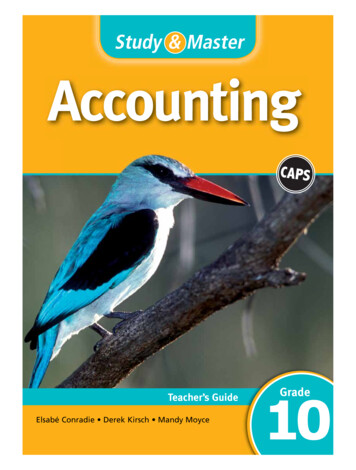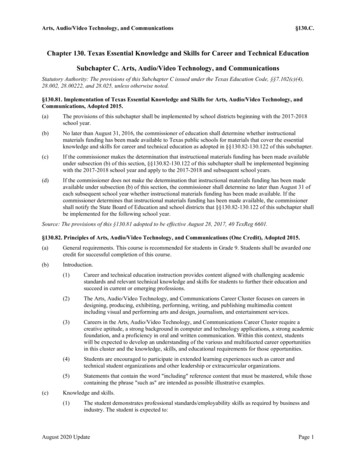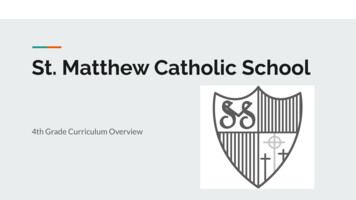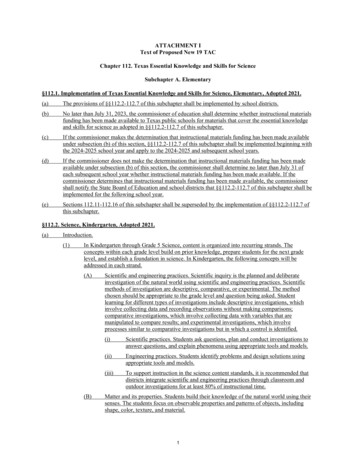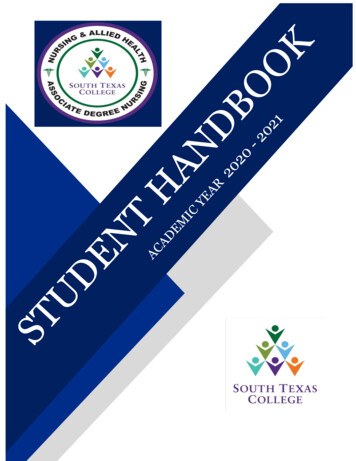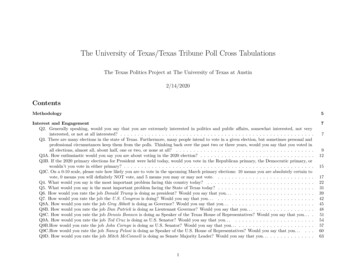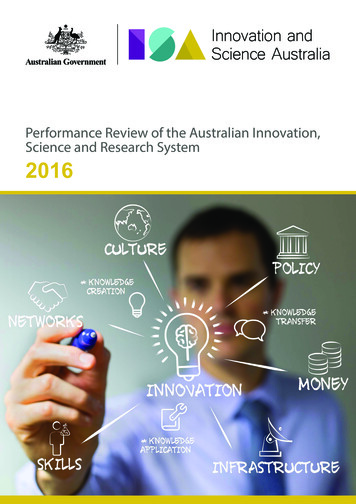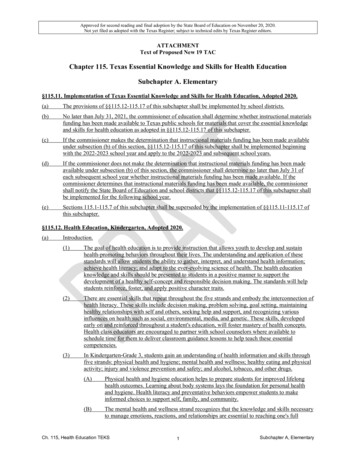
Transcription
Approved for second reading and final adoption by the State Board of Education on November 20, 2020.Not yet filed as adopted with the Texas Register; subject to technical edits by Texas Register editors.ATTACHMENTText of Proposed New 19 TACChapter 115. Texas Essential Knowledge and Skills for Health EducationSubchapter A. Elementary§115.11. Implementation of Texas Essential Knowledge and Skills for Health Education, Adopted 2020.(a)The provisions of §§115.12-115.17 of this subchapter shall be implemented by school districts.(b)No later than July 31, 2021, the commissioner of education shall determine whether instructional materialsfunding has been made available to Texas public schools for materials that cover the essential knowledgeand skills for health education as adopted in §§115.12-115.17 of this subchapter.(c)If the commissioner makes the determination that instructional materials funding has been made availableunder subsection (b) of this section, §§115.12-115.17 of this subchapter shall be implemented beginningwith the 2022-2023 school year and apply to the 2022-2023 and subsequent school years.(d)If the commissioner does not make the determination that instructional materials funding has been madeavailable under subsection (b) of this section, the commissioner shall determine no later than July 31 ofeach subsequent school year whether instructional materials funding has been made available. If thecommissioner determines that instructional materials funding has been made available, the commissionershall notify the State Board of Education and school districts that §§115.12-115.17 of this subchapter shallbe implemented for the following school year.(e)Sections 115.1-115.7 of this subchapter shall be superseded by the implementation of §§115.11-115.17 ofthis subchapter.§115.12. Health Education, Kindergarten, Adopted 2020.(a)Introduction.(1)The goal of health education is to provide instruction that allows youth to develop and sustainhealth-promoting behaviors throughout their lives. The understanding and application of thesestandards will allow students the ability to gather, interpret, and understand health information;achieve health literacy; and adapt to the ever-evolving science of health. The health educationknowledge and skills should be presented to students in a positive manner to support thedevelopment of a healthy self-concept and responsible decision making. The standards will helpstudents reinforce, foster, and apply positive character traits.(2)There are essential skills that repeat throughout the five strands and embody the interconnection ofhealth literacy. These skills include decision making, problem solving, goal setting, maintaininghealthy relationships with self and others, seeking help and support, and recognizing variousinfluences on health such as social, environmental, media, and genetic. These skills, developedearly on and reinforced throughout a student's education, will foster mastery of health concepts.Health class educators are encouraged to partner with school counselors where available toschedule time for them to deliver classroom guidance lessons to help teach these essentialcompetencies.(3)In Kindergarten-Grade 3, students gain an understanding of health information and skills throughfive strands: physical health and hygiene; mental health and wellness; healthy eating and physicalactivity; injury and violence prevention and safety; and alcohol, tobacco, and other drugs.(A)Physical health and hygiene education helps to prepare students for improved lifelonghealth outcomes. Learning about body systems lays the foundation for personal healthand hygiene. Health literacy and preventative behaviors empower students to makeinformed choices to support self, family, and community.(B)The mental health and wellness strand recognizes that the knowledge and skills necessaryto manage emotions, reactions, and relationships are essential to reaching one's fullCh. 115, Health Education TEKS1Subchapter A, Elementary
Approved for second reading and final adoption by the State Board of Education on November 20, 2020.Not yet filed as adopted with the Texas Register; subject to technical edits by Texas Register editors.potential. Students gain knowledge about social and emotional health, includingdeveloping a healthy self-concept, understanding risk and protective factors, andidentifying and managing mental health and wellness concerns. In the early grades,students develop fluency around emotions and self-regulation and understand therelationship between feelings, thoughts, and behavior. In subsequent grades, studentslearn and practice appropriate ways to solve interpersonal conflicts, work to develop apositive self-image, and develop healthy self-management skills.(b)(C)The healthy eating and physical activity strand addresses the importance of nutrition andphysical activity to support a healthy lifestyle. Students apply critical-thinking anddecision-making skills to make positive health choices. Students learn about essentialnutrients, food groups, portion control, government nutritional recommendations, and thehealth benefits of being physically active. Students evaluate the connection betweenphysical activity and nutrition and the prevention of chronic diseases.(D)By focusing on injury and violence prevention and safety, the standards promote studentwell-being and awareness of dangerous situations. Supporting student well-being andproviding instruction in digital citizenship, bullying prevention , first aid, andidentification of safe and unsafe situations creates empowered and educated students whoare able to make decisions that keep themselves and others safe. Beginning inKindergarten and continuing through high school, students gain knowledge and skills tosupport safety and wellness at school, at home, online, and in the community.(E)The standards under the alcohol, tobacco, and other drugs strand focus on a number ofprotective factors that develop empowered students who are able to make better-informeddecisions, including understanding the impact of substance use on physical, mental, andsocial health. Through this strand, students learn key concepts about alcohol, tobacco,and other drugs, including the use, misuse, and physiological effects; short- and longterm impacts on health; treatment; risk and protective factors; and prevention. Theseconcepts introduce healthy alternatives and ways for students to ask for and seek out helpfrom parents and other trusted adults.(4)Statements containing the word "including" reference content that must be mastered, while thosecontaining the phrase "such as" are intended as possible illustrative examples.(5)Students should first seek guidance in the area of health from a parent or legal guardian.Knowledge and skills.(1)Physical health and hygiene--body systems. The student examines the structure, function, andrelationships of body systems and their relevance to personal health. The student is expected toname the five senses.(2)Physical health and hygiene--personal health and hygiene. The student understands health literacy,preventative health behaviors, and how to access and evaluate health care information to makeinformed decisions. The student is expected to:(3)(A)name people who can provide health care guidance such as parents, family members,other trusted adults, teachers, and health care professionals;(B)identify personal hygiene and health habits that help individuals stay healthy such ashand washing and brushing teeth;(C)discuss ways in which germs are transmitted, methods of preventing the spread of germs,and the importance of immunization; and(D)identify head lice and biting insects that may cause illness and their proper removal andcare.Mental health and wellness--social and emotional health. The student identifies and appliesstrategies to develop socio-emotional health, self-regulation, and healthy relationships. Thestudent is expected to:Ch. 115, Health Education TEKS2Subchapter A, Elementary
Approved for second reading and final adoption by the State Board of Education on November 20, 2020.Not yet filed as adopted with the Texas Register; subject to technical edits by Texas Register editors.(4)(A)identify their own feelings and emotions;(B)describe and practice calming and self-management strategies;(C)discuss how friends can influence a person's behavior;(D)demonstrate skills for making new acquaintances;(E)demonstrate respect and communicate appropriately with individuals; and(F)identify and practice ways to solve conflicts with a friend.Mental health and wellness--developing a healthy self-concept. The student develops the capacityfor self-assessment and evaluation, goal setting, and decision making in order to develop a healthyself-concept. The student is expected to:(A)describe positive social skills and personal qualities such as truth, kindness, reliability,and respectfulness; and(B)discuss the meaning of goals and identify at least one health-related goal.(5)Mental health and wellness--identifying and managing mental health and wellness concerns. Thestudent develops and uses appropriate skills to identify and manage conditions related to mentalhealth and wellness. The student is expected to discuss how to treat peers with different learningneeds with dignity.(6)Healthy eating and physical activity--food and beverage daily recommendations. The studentidentifies and explains healthy eating strategies for enhancing and maintaining personal healththroughout the lifespan. The student is expected to:(7)(8)(9)(A)demonstrate an understanding that the human body is composed mostly of water andexplain the importance of drinking water daily;(B)identify healthy portion sizes for common food items;(C)identify types of foods that help the body grow, including fruits and vegetables, dairy,and protein; and(D)identify healthy and unhealthy snack choices.Healthy eating and physical activity--risk and protective factors. The student identifies andexplains risk and protective factors related to healthy eating and physical activity. The student isexpected to:(A)describe basic facts of food allergy safety such as not sharing food and explain theimportance of respecting others who have allergies; and(B)identify habits that help individuals stay healthy such as getting the proper amount ofsleep and daily physical activity.Injury and violence prevention and safety--safety skills and unintentional injury. The studentidentifies and demonstrates safety and first aid knowledge to prevent and treat injuries. Thestudent is expected to:(A)discuss and demonstrate procedures for responding to emergencies, including reporting toa parent or another trusted adult or contacting 911; and(B)identify the purpose and demonstrate the proper use of protective equipment such as seatbelts, booster seats, and bicycle helmets.Injury and violence prevention and safety--healthy relationships and conflict-resolution skills. Thestudent differentiates between healthy and unhealthy relationships and demonstrates effectivestrategies to address conflict. The student is expected to:(A)identify roles and characteristics of a trusted adult;Ch. 115, Health Education TEKS3Subchapter A, Elementary
Approved for second reading and final adoption by the State Board of Education on November 20, 2020.Not yet filed as adopted with the Texas Register; subject to technical edits by Texas Register editors.(10)(B)identify and role play refusal skills such as saying "no" to protect personal space and toavoid unsafe situations [and practice telling a parent or trusted adult if threatened] ; and(C)identify personal space and appropriate boundaries.Injury and violence prevention and safety--healthy home, school, and community climate. Thestudent understands that individual actions and awareness can impact safety, community, andenvironment. The student is expected to:(A)name safe play environments; [and](B)name objects that may be dangerous such as knives, scissors, and screwdrivers andexplain how they can be harmful ; and [.](C)recall personal home address as part of a personal safety plan.(11)Injury and violence prevention and safety--digital citizenship and media. The student understandshow to be a safe and responsible citizen in digital and online environments. The student isexpected to identify situations when one should get help from a teacher, parent, or other trustedadult when made to feel bullied, uncomfortable, or unsafe in a digital or online environment.(12)Injury and violence prevention and safety--interpersonal violence. The student understands theimpact of interpersonal violence and the importance of seeking guidance and help to maintainpersonal safety. The student is expected to:(13)(14)(A)identify bullying behaviors and the role of the bystander;(B)identify ways to discourage bullying;(C)describe appropriate actions to take in response to bullying such as telling a parent oranother [a] trusted adult; and(D)explain and practice how to get help from a parent or another trusted adult when made tofeel uncomfortable or unsafe by another person.Alcohol, tobacco, and other drugs--use, misuse, and physiological effects. The student understandsthe difference between the use and misuse of different substances and how the use and misuse ofsubstances impacts health. The student is expected to:(A)discuss the proper usage of medications; and(B)discuss the harmful effects of alcohol, tobacco, and drugs on physical health.Alcohol, tobacco, and other drugs--risk and protective factors. The student understands howvarious factors can influence decisions regarding substance use and the resources available forhelp. The student is expected to identify [role play] refusal skills and how to get help from a parentor another trusted adult in unsafe situations involving the use or misuse of alcohol, tobacco, andother drugs.§115.13. Health Education, Grade 1, Adopted 2020.(a)Introduction.(1)The goal of health education is to provide instruction that allows youth to develop and sustainhealth-promoting behaviors throughout their lives. The understanding and application of thesestandards will allow students the ability to gather, interpret, and understand health information;achieve health literacy; and adapt to the ever-evolving science of health. The health educationknowledge and skills should be presented to students in a positive manner to support thedevelopment of a healthy self-concept and responsible decision making. The standards will helpstudents reinforce, foster, and apply positive character traits.(2)There are essential skills that repeat throughout the five strands and embody the interconnection ofhealth literacy. These skills include decision making, problem solving, goal setting, maintaininghealthy relationships with self and others, seeking help and support, and recognizing variousCh. 115, Health Education TEKS4Subchapter A, Elementary
Approved for second reading and final adoption by the State Board of Education on November 20, 2020.Not yet filed as adopted with the Texas Register; subject to technical edits by Texas Register editors.influences on health such as social, environmental, media, and genetic. These skills, developedearly on and reinforced throughout a student's education, will foster mastery of health concepts.Health class educators are encouraged to partner with school counselors where available toschedule time for them to deliver classroom guidance lessons to help teach these essentialcompetencies.(3)(b)In Kindergarten-Grade 3, students gain an understanding of health information and skills throughfive strands: physical health and hygiene; mental health and wellness; healthy eating and physicalactivity; injury and violence prevention and safety; and alcohol, tobacco, and other drugs.(A)Physical health and hygiene education helps to prepare students for improved lifelonghealth outcomes. Learning about body systems lays the foundation for personal healthand hygiene. Health literacy and preventative behaviors empower students to makeinformed choices to support self, family, and community.(B)The mental health and wellness strand recognizes that the knowledge and skills necessaryto manage emotions, reactions, and relationships are essential to reaching one's fullpotential. Students gain knowledge about social and emotional health, includingdeveloping a healthy self-concept, understanding risk and protective factors, andidentifying and managing mental health and wellness concerns. In the early grades,students develop fluency around emotions and self-regulation and understand therelationship between feelings, thoughts, and behavior. In subsequent grades, studentslearn and practice appropriate ways to solve interpersonal conflicts, work to develop apositive self-image, and develop healthy self-management skills.(C)The healthy eating and physical activity strand addresses the importance of nutrition andphysical activity to support a healthy lifestyle. Students apply critical-thinking anddecision-making skills to make positive health choices. Students learn about essentialnutrients, food groups, portion control, government nutritional recommendations, and thehealth benefits of being physically active. Students evaluate the connection betweenphysical activity and nutrition and the prevention of chronic diseases.(D)By focusing on injury and violence prevention and safety, the standards promote studentwell-being and awareness of dangerous situations. Supporting student well-being andproviding instruction in digital citizenship, bullying prevention , first aid, andidentification of safe and unsafe situations creates empowered and educated students whoare able to make decisions that keep themselves and others safe. Beginning inKindergarten and continuing through high school, students gain knowledge and skills tosupport safety and wellness at school, at home, online, and in the community.(E)The standards under the alcohol, tobacco, and other drugs strand focus on a number ofprotective factors that develop empowered students who are able to make better-informeddecisions, including understanding the impact of substance use on physical, mental, andsocial health. Through this strand, students learn key concepts about alcohol, tobacco,and other drugs, including the use, misuse, and physiological effects; short- and longterm impacts on health; treatment; risk and protective factors; and prevention. Theseconcepts introduce healthy alternatives and ways for students to ask for and seek out helpfrom parents and other trusted adults.(4)Statements containing the word "including" reference content that must be mastered, while thosecontaining the phrase "such as" are intended as possible illustrative examples.(5)Students should first seek guidance in the area of health from a parent or legal guardian.Knowledge and skills.(1)Physical health and hygiene--body systems. The student examines the structure, function, andrelationships of body systems and their relevance to personal health. The student is expected todemonstrate use of the five senses.Ch. 115, Health Education TEKS5Subchapter A, Elementary
Approved for second reading and final adoption by the State Board of Education on November 20, 2020.Not yet filed as adopted with the Texas Register; subject to technical edits by Texas Register editors.(2)(3)(4)(5)(6)Physical health and hygiene--personal health and hygiene. The student understands health literacy,preventative health behaviors, and how to access and evaluate health care information to makeinformed decisions. The student is expected to:(A)identify types of health care professionals and describe the services they provide such asmedical checkups, dental exams, and vision and hearing screenings;(B)describe personal hygiene and health habits that enhance individual health such aspersonal hygiene, oral hygiene, and getting enough sleep;(C)describe ways in which germs are transmitted, methods of preventing the spread ofgerms, and the importance of immunization; and(D)describe where head lice and biting insects that may cause illness, including ticks andmosquitos, are commonly encountered and how to avoid them.Mental health and wellness--social and emotional health. The student identifies and appliesstrategies to develop socio-emotional health, self-regulation, and healthy relationships. Thestudent is expected to:(A)identify their own feelings and emotions;(B)discuss and explain how emotions can interrupt thinking and the self-managementprocess;(C)describe and practice calming and self-management strategies;(D)describe ways in which peers and families can work together to build healthyrelationships;(E)describe ways to build and maintain friendships;(F)identify ways to respectfully communicate verbally and nonverbally;(G)identify feelings and emotions expressed by others; and(H)identify and practice ways to solve conflicts with friends and peers.Mental health and wellness--developing a healthy self-concept. The student develops the capacityfor self-assessment and evaluation, goal setting, and decision making in order to develop a healthyself-concept. The student is expected to:(A)discuss ways to be kind to self and how to identify areas for growth; and(B)explain the importance of goal setting and task completion.Mental health and wellness--identifying and managing mental health and wellness concerns. Thestudent develops and uses appropriate skills to identify and manage conditions related to mentalhealth and wellness. The student is expected to:(A)discuss and demonstrate how to treat peers with different learning needs with dignity andrespect;(B)identify situations that can create positive stress and positive emotions; and(C)discuss the signs and symptoms associated with negative stress such as loss or grief.Healthy eating and physical activity--food and beverage daily recommendations. The studentidentifies and explains healthy eating strategies for enhancing and maintaining personal healththroughout the lifespan. The student is expected to:(A)explain that fruits, proteins, vegetables, and dairy provide essential vitamins andminerals;(B)identify recommended portion sizes by comparing portions to familiar objects such as agolf ball for a cookie or a frisbee for a dinner plate;Ch. 115, Health Education TEKS6Subchapter A, Elementary
Approved for second reading and final adoption by the State Board of Education on November 20, 2020.Not yet filed as adopted with the Texas Register; subject to technical edits by Texas Register editors.(C)identify the food groups and classify examples of foods into each group; and(D)identify ingredients that make foods and drinks unhealthy such as added sugar and othersweeteners.(7)Healthy eating and physical activity--nutrition and physical activity literacy. The student obtains,processes, and understands basic physical activity and nutrition information needed to makehealth-promoting decisions. The student is expected to identify examples of health informationprovided by various media and how the examples affect nutritional habits and physical activity.(8)Healthy eating and physical activity--risk and protective factors. The student identifies andexplains risk and protective factors related to healthy eating and physical activity. The student isexpected to:(9)(10)(11)(A)identify common food allergies and explain the importance of respecting others who haveallergies; and(B)describe habits that improve individual health such as getting enough sleep, eatingnutritious foods, and exercising.Injury and violence prevention and safety--safety skills and unintentional injury. The studentidentifies and demonstrates safety and first aid knowledge to prevent and treat injuries. Thestudent is expected to:(A)discuss and demonstrate strategies to keep self and others safe by staying away fromdangerous situations and reporting to a parent or another trusted adult or contacting 911;and(B)identify the purpose and demonstrate proper use of protective equipment such as seatbelts, booster seats, and bicycle helmets.Injury and violence prevention and safety--healthy relationships and conflict-resolution skills. Thestudent differentiates between healthy and unhealthy relationships and demonstrates effectivestrategies to address conflict. The student is expected to:(A)practice refusal skills to protect personal space and avoid unsafe situations; [and](B)identify appropriate personal boundaries, privacy, and space ; and [.](C)recall parents'/caregivers' phone numbers as part of a personal safety plan.Injury and violence prevention and safety--healthy home, school, and community climate. Thestudent understands that individual actions and awareness can impact safety, community, andenvironment. The student is expected to:(A)describe the difference between safe and unsafe environments; and(B)identify ways to avoid weapons [, drugs,] and harming oneself or others by staying awayfrom dangerous situations and reporting to a parent or another trusted adult.(12)Injury and violence prevention and safety--digital citizenship and media. The student understandshow to be a safe and responsible citizen in digital and online environments. The student isexpected to demonstrate how to get help from a teacher, parent, or other trusted adult when madeto feel bullied, uncomfortable, or unsafe in a digital or online environment.(13)Injury and violence prevention and safety--interpersonal violence. The student understands theimpact of interpersonal violence and the importance of seeking guidance and help to maintainpersonal safety. The student is expected to:(A)describe consequences for both the victim and the bully and the impact of bullying on thevictim;(B)discuss ways of discouraging bullying;(C)explain the differences between teasing, joking, and playing around and bullying; andCh. 115, Health Education TEKS7Subchapter A, Elementary
Approved for second reading and final adoption by the State Board of Education on November 20, 2020.Not yet filed as adopted with the Texas Register; subject to technical edits by Texas Register editors.(D)(14)identify how to get help from a parent or another trusted adult when made to feeluncomfortable or unsafe by another person.Alcohol, tobacco, and other drugs--use, misuse, and physiological effects. The student understandsthe difference between the use and misuse of different substances and how the use and misuse ofsubstances impacts health. The student is expected to:(A)identify the difference between over-the-counter and prescription drugs; and(B)identify and describe the harmful effects of alcohol, tobacco, other drugs, and dangeroussubstances such as inhalants, vaping products, and household products on physical health.(15)Alcohol, tobacco, and other drugs--treatment. The student understands how to seek emergencyhelp for self and others in poisoning and overdose situations. The student is expected to describewhat poisoning or overdose could look like and identify how to respond, including who to contactfor help.(16)Alcohol, tobacco, and other drugs--risk and protective factors. The student understands howvarious factors can influence decisions regarding substance use and the resources available forhelp. The student is expected to identify how to get help from a parent or another trusted adultrelated to alcohol, tobacco, and drug abuse.(17)Alcohol, tobacco, and other drugs--prevention. The student demonstrates refusal skills to avoidsubstance use and misuse. The student is expected to identify unsafe situations and practicestrategies to avoid risky behaviors related to alcohol, tobacco, and other drugs.§115.14. Health Education, Grade 2, Adopted 2020.(a)Introduction.(1)The goal of health education is to provide instruction that allows youth to develop and sustainhealth-promoting behaviors throughout their lives. The understanding and application of thesestandards will allow students the ability to gather, interpret, and understand health information;achieve health literacy; and adapt to the ever-evolving science of health. The health educationknowledge and skills should be presented to students in a positive manner to support thedevelopment of a healthy self-concept and responsible decision making. The standards will helpstudents reinforce, foster, and apply positive character traits.(2)There are essential skills that repeat throughout the five strands and embody the interconnection ofhealth literacy. These skills include decision making, problem solving, goal setting, maintaininghealthy relationships with self and others, seeking help and support, and recognizing variousinfluences on health such as social, environmental, media, and genetic. These skills, developedearly on and reinforced throughout a student's education, will foster mastery of health concepts.Health class educators are encouraged to partner with school counselors where available toschedule time for them to deliver classroom guidance lessons to help teach these essentialcompetencies.(3)In Kindergarten-Grade 3, students gain an understanding of health information and skills throughfive strands: physical health and hygiene; mental health and wellness; healthy eating and physicalactivity; injury and violence prevention and safety; and alcohol, tobacco, and other drugs.(A)Physical health and hygiene education helps to prepare students for improved lifelonghealth outcomes. Learning about body systems lays the foundation for personal healthand hygiene. Health literacy and preventative behaviors empower students to makeinformed choices to support self, family, and community.(B)The mental health and wellness strand recognizes that the knowledge and skills necessaryto manage emotions, reactions, and relationships are essential to reaching one's fullpotential. Students gain knowledge about social and emotional health, includingdeveloping a healthy self-concept, understanding risk and protective factors, andidenti
shall notify the State Board of Education and school districts that §§115.12-115.17 of this subchapter shall be implemented for the following school year. (e) Sections 115.1-115.7 of this subchapter shall be superseded by the implementation of §§115.11-115.17 of this subchapter. §115.12. Health Education, Kindergarten, Adopted 2020.



